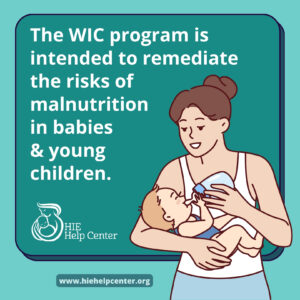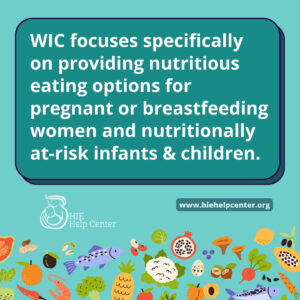Jump To:
- Supplemental Nutrition Assistance Program (SNAP)
- Women, Infant and Children Supplemental Nutrition Program (WIC)
- School Nutrition Programs
- Emergency Food Assistance: Food Banks
- About HIE Help Center
There are several programs available to help ease hunger, provide nutritional assistance and alleviate poverty in the United States. While each program has different requirements and funding availabilities, they all focus on providing nutrition to families and children who require some extra support. These programs include the Supplemental Nutrition Assistance Program (SNAP), the Women, Infant and Children Supplemental Nutrition Program (WIC), and School Nutrition Programs.
Supplemental Nutrition Assistance Program (SNAP)
SNAP is the largest US Department of Agriculture nutrition program, designed specifically to help low-income and vulnerable families meet their nutritional needs by providing families with EBT cards loaded with usable funds once a month. These cards can be used at grocery stores, big box stores that sell food, farmer’s markets and other food-selling locations. The program has gone through several iterations, and now has strict requirements regarding assets and income, household size, and what EBT money can and cannot buy. The program is funded 100% by the federal government, although state governments share administrative costs.
How is eligibility for SNAP determined?
SNAP takes into account the incomes of all family members in the household, including the income from underage minors’ part-time work. An exception to this is if the household contains an individual who is over 60, disabled, and unable to prepare meals. Elderly individuals in institutional settings can’t get SNAP benefits if meals are given at the institution, while residents of federally-subsidized housing or non-profit group homes can.
How can I apply for SNAP?
To apply for SNAP, applicants should visit their state Department of Human Services or Department of Public assistance website. There, they will be able to view what kinds of documents they should gather. Once they have filled out and submitted an application, they must meet with a caseworker in person. During the meeting, they should have required documents ready and organized for review. It takes about 30 days for an application to be reviewed. Applications can be denied, but all states have a review or appeals process. The exact procedures vary state to state.
There are certain situations where a person can apply for emergency SNAP benefits, when funding will be approved within a week instead of approximately a month. To continue receiving SNAP benefits after the emergency period, the individuals must go through the standard SNAP application process.
Women, Infant and Children Supplemental Nutrition Program (WIC)
The WIC program is similar in its goals to the SNAP program, but focuses specifically on at-risk mothers, infants and children. WIC is intended to remediate the risks of malnutrition (such as premature birth, low birth weight and failure to thrive) in babies and young children. The program focuses specifically on providing nutritious eating options for pregnant or breastfeeding women and nutritionally at-risk infants and children.
 What groups are served by WIC?
What groups are served by WIC?
- Pregnant mothers
- Breastfeeding mothers
- Unborn children
- Newborns
- Children under age 5
- Certain fathers (under specific guidelines)
What does WIC provide?
WIC provides paper vouchers outlining specific sizes and quantities of particular items that individuals can receive, whether it is in a grocery store, a warehouse, a farmer’s market, or via food delivery directly to a home. These items are specifically tailored to that individual’s nutritional needs and medical situation. At this point in time, the WIC has primarily transitioned from paper voucher to electronic EBT (electronic benefit transfer) cards as a form of payment.
The program also focuses on providing healthcare and social assistance, breastfeeding support, breast pumps, and educational services to mothers in order to ensure their children have a healthy start to life. This program is overseen by the USDA’s Food and Nutrition Services Agency (FNS), and provides a limited number and type of nutrient-dense foods (unlike SNAP, which allows the buying of most types of food in a grocery store).
Am I eligible for WIC?
 The eligibility requirements for the WIC program are highly specific. Individuals who wish to apply to the program can use the WIC pre-screening tool to help determine if they should consider applying. Nutritional risk is assessed by a health professional (an approved doctor, nurse or nutritionist), though those interested in the program can look at the WIC Nutrition Risk Descriptions to see which conditions are under the category of at-risk. Other requirements, such as income eligibility and residency, are also covered in the above eligibility requirements.
The eligibility requirements for the WIC program are highly specific. Individuals who wish to apply to the program can use the WIC pre-screening tool to help determine if they should consider applying. Nutritional risk is assessed by a health professional (an approved doctor, nurse or nutritionist), though those interested in the program can look at the WIC Nutrition Risk Descriptions to see which conditions are under the category of at-risk. Other requirements, such as income eligibility and residency, are also covered in the above eligibility requirements.
Individuals eligible for Medicaid, SNAP or TANF have automatic income eligibility for WIC; other requirements still apply. It should be noted, however, that not everyone who is eligible will receive WIC. Due to limited funding, there is a priority system in place that classifies different people into different priority tiers. Individuals must also re-apply every six months.
How do I apply for WIC?
To apply for WIC, individuals should go to their local state health organization or community health department. In most cases, online applications are available. The application process involves meeting with a caseworker, as well as a health/nutrition assessment. A list of required documents for caseworker meetings can be found here.
To maximize the chances of being granted WIC aid, it is important to apply early and have all documentation ready and organized for the caseworker meeting.
For more questions about the WIC program, see the USDA’s WIC FAQs.
School Nutrition Programs
There are several programs available to help children with disabilities have proper nutrition in a school setting. These programs include:
In addition to these programs (which operate during the school year and are administered via schools), the Summer Food Service Program provides meals to low-income children when the school year is not in session. Most of these programs appear in low-income areas where at least one-half of residents live at or below the poverty level. Often, school nutrition programs are operated out of churches, community centers and/or other nonprofit organizations. If a child has disabilities, they may qualify for community activities at community centers; as part of these programs, they may also receive meals or snacks as part of the summer food program. To find a summer food service program, click here.
How do I know if my child is eligible for School Nutrition Programs?
Parents can apply for all of these programs by applying via a school meals application, which is usually included in yearly school registration packets sent home at the start of each school year. To qualify for free meals, household income must be at or below 130% of the poverty level; to qualify for reduced meals, household income must be at or below 185% of the poverty level.
How do I apply for School Nutrition Programs?
If parents miss the initial application packet, they can still apply at any point during the school year. An online application is available for some schools, but it varies by district. School districts let parents know of their determination in writing. They can either approve the family for free meals or low-cost meals, or they can deny the family. The parent will be given information on how to appeal a decision via a conference if denied; if there is still disagreement, parents can ask for a local education agency official to oversee a re-investigation of the decision.
What if my child has special dietary needs?
Under IDEA, schools must make accommodations for children with disabilities. If a disabled child has special dietary needs, schools must prepare alternative meal options via food substitutions or alternatives. To obtain these accommodations, parents must provide a written document from a doctor specifying what food changes need to be made and how these changes should be carried out.
If a student has an Individualized Education Plan (IEP), they are eligible for school nutrition services at no cost to parents. Parents can specifically request nutritional services during the IEP drafting and revision process. Depending on the type, extent and severity of the disability, the child may be eligible to receive additional nutrition-related services, such as nutritional consulting, assistance in eating from a trained special education teacher or assistance in developing feeding skill.
Emergency Food Assistance: Food Banks
In certain situations, families may need immediate assistance obtaining food. In these cases, they may be able to find assistance from local soup kitchens or food banks. Food banks are set up to provide immediate assistance to families who require help with meeting nutritional needs. They also sometimes provide other items to families, such as personal hygiene items, cleaning supplies, and soap.
 Who operates food banks?
Who operates food banks?
Food banks are often run by nonprofit groups, churches, local governments or private companies. Some food banks operate as a warehouse, distributing food out to smaller distribution centers. In other cases, they handle distribution directly. Usually, these food banks are independent organizations. In both situations, food banks may fill the gap between government benefits and actual family needs.
To find a food bank in your area, use one of the following websites:
About HIE Help Center
The HIE Help Center is run by ABC Law Centers, a medical malpractice law firm that exclusively handles cases involving hypoxic-ischemic encephalopathy. Our team of lawyers has advocating for children with HIE and related disabilities since the firm’s inception in 1997. With our years of experience, we are prepared to fight to obtain the compensation necessary to cover a lifetime of care for your child.
If you suspect your child’s HIE was caused by medical negligence, contact us to learn more about pursuing a case. We provide free legal consultations, during which we will inform you of your options and answer any questions you have. Don’t worry about the cost, you pay nothing throughout the entire legal process until we obtain a favorable settlement.

